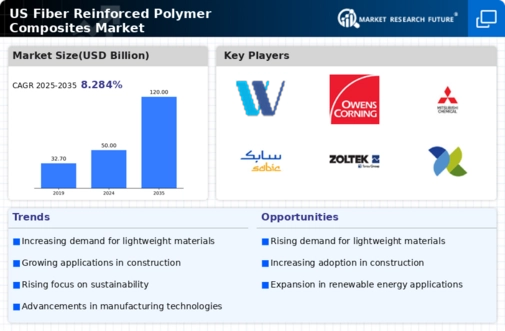The US Fiber Reinforced Polymer Composites Market is characterized by its dynamic nature, driven by various factors including technological advancements, increasing demand for lightweight materials, and a focus on sustainability across various industries. The market has evolved significantly with new manufacturing techniques and product innovations, positioning itself as a crucial component in sectors such as automotive, aerospace, construction, and marine. Competitive insights indicate a multitude of players who are striving to enhance their product offerings and expand their market share through strategic collaborations, investments in research and development, and mergers and acquisitions.
This competitive landscape fosters a continuous cycle of innovation and adaptation to meet the growing needs of diverse applications where fiber reinforced polymers provide significant advantages in terms of strength-to-weight ratio and durability.In the context of the US Fiber Reinforced Polymer Composites Market, BASF Corporation stands out due to its extensive portfolio of advanced materials and strong market presence. The company leverages its deep expertise in chemistry and materials science to develop high-performance composite solutions that cater to various industries.
BASF has made substantial investments in innovation and research, focusing on enhancing the mechanical properties and performance of its polymer composites. This investment facilitates the introduction of novel products with improved characteristics that meet stringent industry standards. BASF's strategic partnerships and collaborations with key players in the market further bolster its competitive position, enabling the company to respond effectively to evolving customer needs and maintain a leadership role among its competitors.Westlake Chemical has established itself as a formidable player in the US Fiber Reinforced Polymer Composites Market, demonstrating a strong presence through its comprehensive range of products and services.
The company thrives on its commitment to quality and innovation, producing fiber reinforced polymer composites that are utilized across various applications, including construction and infrastructure. Westlake Chemical's strengths lie in its ability to integrate backward and forward into its supply chain, ensuring a consistent quality flow in its manufacturing processes. The company has actively pursued mergers and acquisitions to expand its capabilities and market reach, allowing it to diversify its product offerings and tap into new customer segments within the US.
Westlake’s dedication to sustainability and eco-friendly practices further enhances its market appeal, placing it in alignment with the growing trend towards environmentally conscious materials in the composites sector.




















Leave a Comment